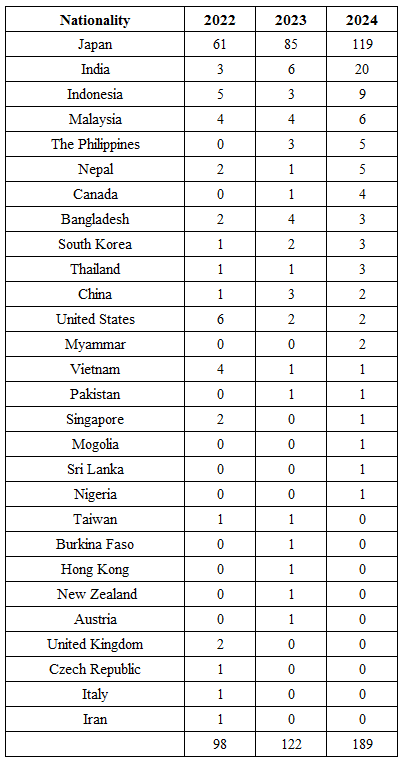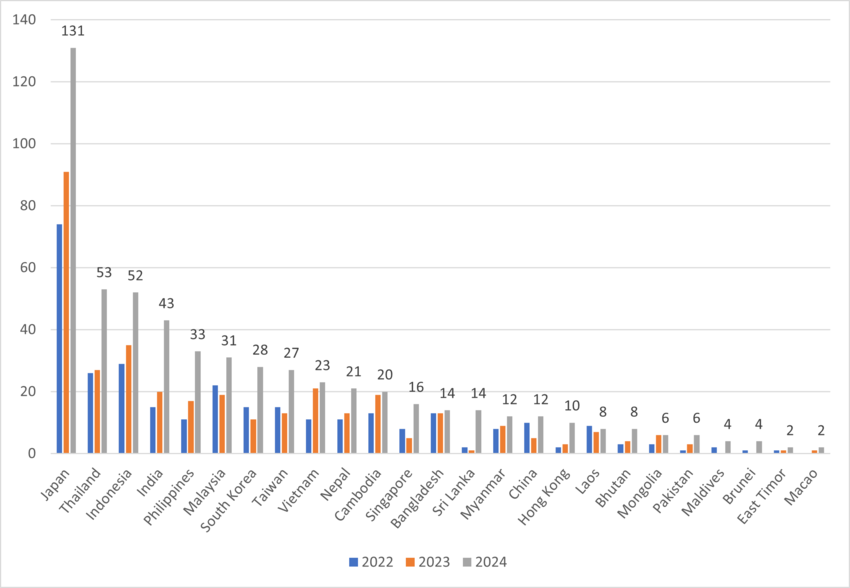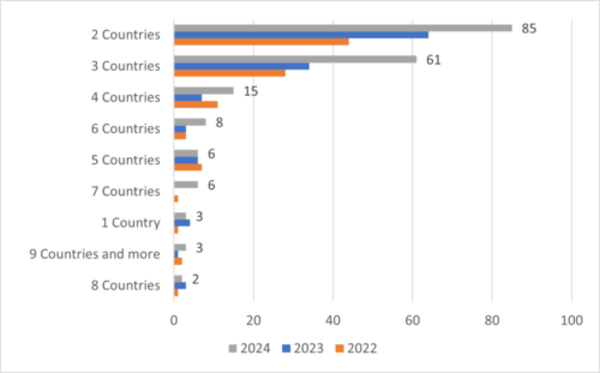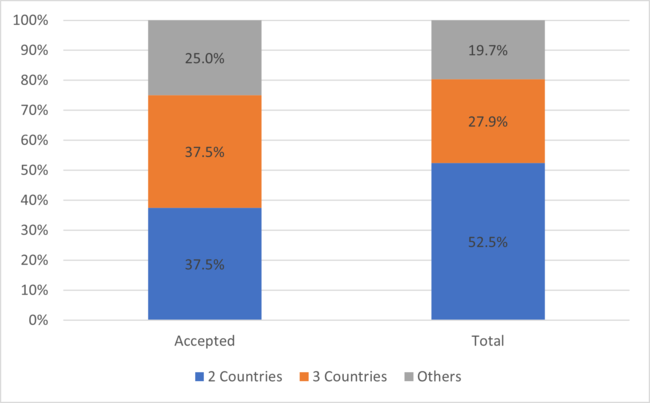Selection Committee Chair Prof. Shigeto Sonoda
Outline of Fiscal 2024 International Grant Program “Cultivating Empathy Through Learning from Our Neighbors: Practitioners’ Exchange on Common Issues in Asia”
There are news reports that the number of COVID-19 infections is increasing again this summer. However, this has not affected overseas travel. Possibly due in part to the weaker yen, the number of tourists coming to Japan is about to reach a record-high. The number of International Grant Program applications received was 189, the largest number since I became the selection committee chair in 2019.
This fiscal year, in the International Grant Program, we called for proposed projects that are aimed at solving common issues in Asia through learning from each other and include the following four elements, as before. The application guidelines have not changed from last year.
(1) Transnationality: The project must cover at least two countries in East Asia, Southeast Asia, and South Asia, and the project members must also be from at least two countries. In addition, any achievement made through the project or an effect produced by it must cover multiple countries.
(2) Cross Sectoral Approach: A sufficient number of experts from multiple sectors (such as researchers, NPO staff, businesspersons, and government officials), who are to solve the problem, must be participating in the project under an organic relationship.
(3) Mutual Learning: Project participants must have built a relationship of mutual learning to carry out the project.
(4) Foresight: The project must have a clear vision of its outcomes and must consider the impact it will have after the end of the grant and the possibility of its future development. It must also cover problems that could occur in the future and reflect a new perspective beyond conventional frameworks.
As I pointed out in preceding years, while it may be easy to fulfill conditions (1) and (4), it is difficult to fulfill (2) and (3). Therefore, high level of ingenuity is required to be a successful proposal for the application. In particular, several applications from people or organizations with experience implementing support projects either lacked elements addressing (3) or were insufficient in this respect. This has remained unchanged from preceding years.
Overview of the Situation and Details of Application
The open call for proposals started on April 1 in fiscal 2024, and applications were accepted for two months until June 1. The Foundation held two online briefing sessions, one on April 16 and the other on April 25. Nearly 150 people participated in the sessions, which was 1.5 times larger than last year at the same point. Sixty-six prior consultations were provided face-to-face, online or in other forms. We had 1,053 pre-application registrations, a significant increase from the 267 registrations last year. Program officers (POs) in charge of the registration process were initially concerned that it was a cyberattack. They said that this was a result of a rapid increase in people from South Asia having access to the program. However, slightly below 18% of the pre-registrants, 189 of them, advanced to the final application process. This means there were not too many applications to evaluate.
Of these 189 applications, 35 applied for the one-year grant, which is around 18% of the applications. This is close to the year before last (17.3%).
The distribution of nationalities of applicants is shown in Table 1. In fiscal 2024, a little less than 63% of all applicants were Japanese nationals. This is also close to the fiscal 2022 level. Partly because this is the third year since the program began to cover South Asia, there was an increase in the number of applicants of Indian and Nepali nationalities. This trend was also seen last fiscal year.
Table 1: Distribution of the nationalities of project representatives for fiscal 2022-2024

Fig. 1 shows the distribution of countries/regions stated in the proposed projects and Fig. 2 shows the number of the countries/regions covered by the project.
More projects covered Southeast Asian countries like Thailand, Indonesia, the Philippines, and Malaysia than last year. There was also an increase in proposed projects covering South Asian counties including India, Nepal and Sri Lanka. We had many proposals for projects that cover fewer countries or regions, for example, two or three countries. This is another trend that was also seen last fiscal year.
Fig. 1: Targeted countries/regions that were stated in application forms for fiscal 2022- 2024

Fig. 2: Number of targeted countries/regions that were stated in application forms in 2022-2024

Selection process and results
The selection committee is made up of four members including the committee chair. The members have remained unchanged for three fiscal years.
First, POs sorted out submitted documents and closely reviewed all of the applications. They eliminated incomplete application forms and applications that were judged not to include the four elements described above, before the selection committee members were asked to evaluate the remaining applications.
Next, the four members of the selection committee read the applications carefully and selected the applications that they could recommend, with some weight on the projects that the committee members found most impressive. When a question arose about project details, schedule, budget plans or any other related matters, or room for improvement was found in the dissemination of achievements and results, the selection committee members informed the POs of this.
The committee eliminated applications that had not been recommended by anyone. All members of the selection committee commented on all of the applications, and carefully examined the applicants' answers to questions from the committee members before deciding whether to select them. They made decisions about the winning projects by checking to ensure that there are not too many overlaps in the countries or regions covered and project themes and adjusting the final amounts of the grants to 70,000,000 yen in total.
The eight projects selected for this fiscal year have the following characteristics.
First, many projects covered two countries (three projects) or three (three projects), probably reflecting the distribution of all of the applications (Fig. 3), and creative measures were devised to prevent management costs being too high. In addition, while there were 35 proposed one-year grant projects, none of them were selected. This is yet another trend that was also observed last year.
Fig. 3: Numbers of targeted countries/regions that were stated in the applications: Ratios to the number of selected projects and the total number of applications
(%)

Second, the past recipients of Toyota Foundation grants were a larger proportion of the successful applicants than before (including recipients of grants from programs other than the International Grant Program). Of the representatives stated in all of the application forms submitted this fiscal year, the representatives of 28 of the proposed projects said that they had received grants from the Toyota Foundation before, which is approx. 15% of all of the proposals received. However, the representatives of five of the eight selected projects said that they had previously received grants from the Foundation, which is 62.5% of the selected projects. I will refer to this point again later.
Third, environmental protection, disaster prevention, poverty, and combinations of these issues were the issues that many of the successful applications were focused on. This fiscal year, there were not as many applications related to immigrants or refugees as there had been before. This is also estimated to be because the grant of Special Subject “Migrants and Japanese Society” was introduced in fiscal 2019 and many applicants shifted to this category.
Introducing Adopted Projects
Two of this fiscal year's winning projects which were relatively highly evaluated by the selection committee members are introduced below.
| Reiko Harima |
| Migrant Returnees' Exchange: Building a Forum for Sharing Experiences in Southeast Asian Countries of Origin |
| Countries: Cambodia, Indonesia, Myanmar, Thailand, Vietnam, and Japan |
| Term: 2 years |
| Amount: 9,800,000 yen |
This project creates a forum for people from the Mekong Region who have been migrant workers in Japan and have now returned to their home countries. In the forum, the various realities of migrant work are shared not only between forum participants but also with related people from each country and from embassies in Japan, who participate online, to discuss and shape the future political measures that will be necessary. The idea of creating a forum for advocacy is based on the rich experience of the project representative, who has long been engaged in activities in the region. The project's feasibility and the reliability of its operation were evaluated highly. On the other hand, it is hoped, for example, that research will be conducted to delve deeply into the level of achievement of the original purposes of the Technical Intern Training Program, such as to what degree the people who have worked in Japan as technical intern trainees have actually acquired skills and use them in their countries, after considering ethical issues.
| Jin Sato |
| Community-level adaptation to climate change in the lower Mekong region and mutual learning for the just-in-time provision of information. |
| Target Countries: Cambodia and Thailand |
| Grant Period: 2 years |
| Grant Amounts: 9,800,000 yen |
This project encourages mutual learning involving three parties: people participating in water depth surveys along the Mekong River in Thailand, NGO personnel operating sensor-based early warning systems in Cambodia and experts such as hydrologists. The aim is to model the ideal form of voluntary river management activities and make this visible so that it can be shared with external audiences. The approach, which seeks to identify specifics associated with the climate change about the situations in multiple countries, including the river management situations, and methods for enabling community participation, is in line with the objectives of the International Grant Program, and its validity was evaluated highly. However, it was mentioned that a hypothesis needed to be made in advance about the kind of information that would be provided on a just-in-time basis and the kind of network that should be built, based on the local knowledge referenced in the proposal, rather than playing it by ear.
Conclusion
As mentioned above, the majority of the project proposals selected this fiscal year were written by representatives who had previously received grants from the Toyota Foundation. We believe this is a result of selection committee members remaining faithful to the selection criteria when evaluating the applications and also the result of the continued development of the representatives of projects which had received grants in the past. The selection committee members take their time when selecting projects, and the committee makes its decisions after a detailed review of the projects. The process is fair, but it is difficult to judge whether it is good in the long term as well.
Since I become the committee chair, each committee member has always provided some remarks after the committee meeting. This year, as in past years, the committee members provided their opinions freely. One member's opinion was slightly radical. He said, "As long as we are selecting projects by screening applications, how well each application is written is a factor that determines whether the project is selected or not. If we really want to receive novel proposals from NGOs and various other activists, we should do direct recruitment instead of screening applications." It is true that, in reality, applications submitted by young people tend to be unsuccessful due to how well the documents are written. Also, this year I had the impression that there were more applications than before that looked similar to applications I had seen before. While the brand of the International Grant Program has been established—actually, it was highly competitive again this year, with the successful application rate being slightly above 4.2%—it may be time for the Foundation to take on a new challenge.
Having served as the selection committee chair for the six years since fiscal 2019, this is the last selection during my term of office. Selection was difficult every time, but I always learned something. I would like to express my sincere gratitude to the Foundation for having given me these learning opportunities.
